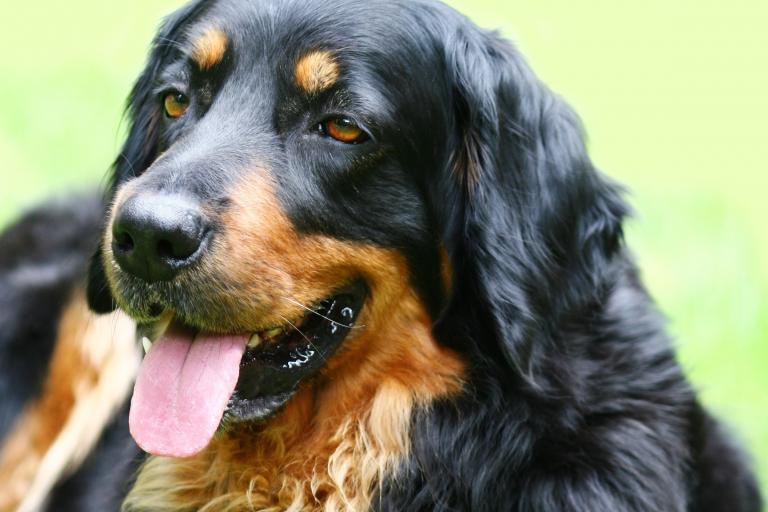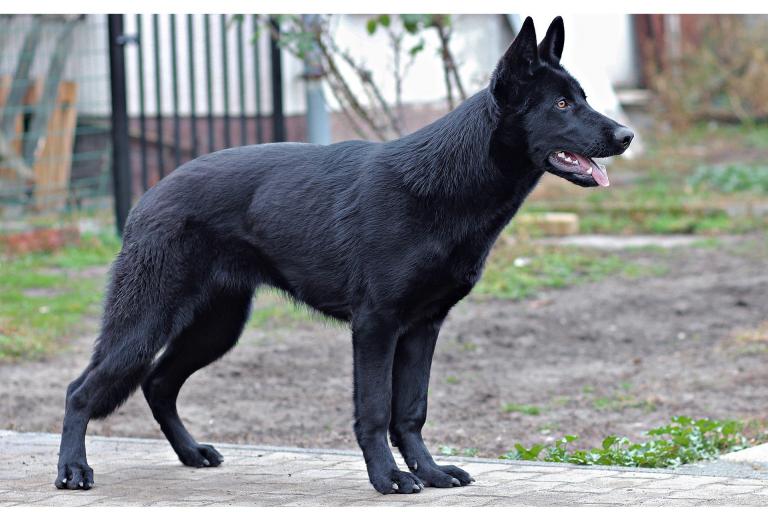Agouti (Coat colour A-Locus Dog)
The base colour of the dog is determined by the interaction of the A locus (Agouti), the E locus (Extension) and the K locus (BlacK). The alleles of these loci determine if and where the pigment eumelanin (black colour) and the pigment phaeomelanin (red colour) can be produced and how these two are distributed over the body.
The A locus has several alleles that control the ratio of black to red pigment in the melanocytes (pigment-producing cells) and thus change the distribution of black pigment over the body.
Genetic Test: available in Shop
General Information
The single genes are in a dominance order. If a higher-ranking (more dominant) allele is present, it also covers existing lower-ranking alleles. Depending on the combination of alleles present, different phenotypes of the dog can occur.
- The Ay allele is inherited dominantly, stands above the others and codes for Fawn/Sable.
- The aw allele is inherited recessively and codes for the Wild Colour ("wolf colour").
- The at allele is inherited recessively and codes for the "Black-and-Tan".
- The a allele is inherited recessively and codes for Recessive Black.
Effects of/on other loci:
- E locus: The pigment eumelanin (black colour) must be produced (E/E or E/e) for the expressions of the alleles of the A locus to be visible in the phenotype. Dogs with the light base colour (e/e) can be carriers for the A alleles, but these are not visible in the phenotype.
- K locus: The expression of the alleles of the A-locus are only visible in the phenotype if the dog is not dominant black (ky/ky). The colour dominant black (K/K, K/ky) hides all A alleles expressions, these dogs can be carriers of the A alleles.
Test Information
Locus Information: A-Locus
This test detects various changes in single base pairs in the ASIP Gen.
Test in Shop
Also in the:
Genotype and Lab Report
Inheritance: autosomal-recessive
→ Inheritance follows the order of dominance for the gene.
- Animals with one or two copies of the gene (AY/a, AY/AY) show the fawn/sable phenotype.
- Animals with one or two copies of the gene (aw/a, aw/aw) show the phenotype wild colour ("wolf colour").
- Animals with one or two copies of the gene (at/a, at/at) show the phenotype "Tan pattern/Black marks".
- Animals with no copy of the gene (a/a) are Recessive Black.
Genotypes
Ay/Ay = Two copies Ay
The colour Fawn/Sable is expressed and will be passed on to the offspring with a probability of 100%.
Ay/aw = One copy Ay and one copy aw
The colour Fawn/Sable is expressed and will be passed on to the offspring with a probability of 50%. The hidden aw allele is also passed on at 50%.
Ay/at = One copy Ay and one copy at
The colour Fawn/Sable is expressed and will be passed on to the offspring with a probability of 50%. The hidden at allele is also passed on at 50%.
Ay/a = One copy Ay and one copy a
The colour Fawn/Sable is expressed and will be passed on to the offspring with a probability of 50%. The hidden a allele is also passed on at 50%.
aw/aw = Two copies aw
The colour wild colour ("wolf colour") is expressed and will be passed on to the offspring with a probability of 100%.
aw/at = One copy aw and one copy at
The colour wild colour ("wolf colour") is expressed and will be passed on to the offspring with a probability of 50%. The hidden at allele is also passed on at 50%.
aw/a = One copy aw and one copy a
The colour wild colour ("wolf colour") is expressed and will be passed on to the offspring with a probability of 50%. The hidden a allele is also passed on at 50%.
at/at = Two copies aw
The colour Black-and-Tan is expressed and will be passed on to the offspring with a probability of 100%.
at/a = One copy at and one copy a
The colour Black-and-Tan is expressed and will be passed on to the offspring with a probability of 50%. The hidden a allele is also passed on at 50%.
a/a = Two copies aa
The colour Recessive Black is expressed and will be passed on to the offspring with a probability of 100%.
Appearance
Literature
Kerns, JA., Newton, J., Berryere, TG., Rubin, EM., Cheng, JF., Schmutz, SM., Barsh, GS.: Characterization of the dog Agouti gene and a non agouti mutation in German Shepherd Dogs. Mamm Genome 15:798-808, 2004. Pubmed reference: 15520882. DOI: 10.1007/s00335-004-2377-1
Berryere, TG., Kerns, JA., Barsh, GS., Schmutz, SM.: Association of an Agouti allele with fawn or sable coat color in domestic dogs. Mamm Genome 16:262-72, 2005. Pubmed reference: 15965787. DOI: 10.1007/s00335-004-2445-6
Further information is available at Online Mendelian Inheritance in Animals.



